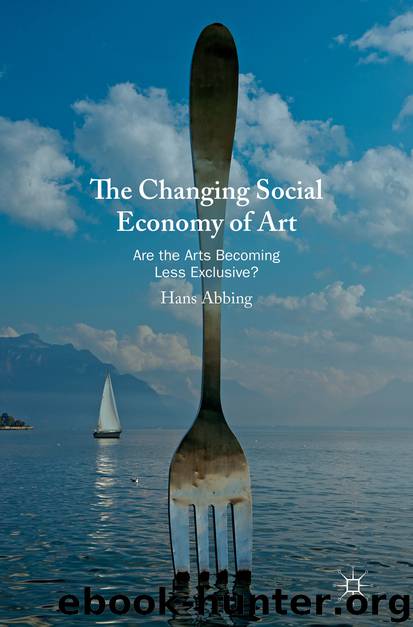The Changing Social Economy of Art by Hans Abbing

Author:Hans Abbing
Language: eng
Format: epub
ISBN: 9783030216689
Publisher: Springer International Publishing
Attempts at Inclusion
(57) During the period of serious art: GROUPS OF ART-LOVERS WANT TO BRING ART TO THE PROLETARIAT. THEY ATTEMPT TO ELEVATE THE WORKERS OR PURSUE ECONOMIC GOALS. THE ATTEMPTS ARE PATERNALISTIC AND UNSUCCESSFUL. So far, I discussed mechanisms of exclusion, which make participation in live events in art-buildings and visits to museums unattractive for lower-class people. This is not the whole story. All through the serious art period, there are art-lovers who want to bring serious art to them. Till the present day—be it less outspoken—a belief that it is important to let “others” get acquainted with serious art, remains important among art-lovers. Governments often agree. Earlier the term “dissemination ” is used; art must be disseminated. Attempts were little successful. Now the use of the term “participation” is common; others must also participate.
Although in the early stage of the serious art period art-lovers appreciate not to have to share their art events anymore with frivolous and “uncivilized” aristocrats and higher bourgeois, they nevertheless also worry about their absence. They adhere to an educational or civilizing ideal and want to elevate them, or they want to assist them in self-education. A “Bildungsideal” is important./23 The art-lovers, moreover, need them, because, given their own limited number, they have a hard time funding their art events. They therefore encourage well-to-do, but in their eyes little-cultured bourgeois to develop an interest in serious art and to start visiting the serious art events and accept the subdued behavior and still consumption practice. Often the encouragement is successful—be it sometimes only in the case of the sons and daughters. Therefore, with respect to higher middle-class people, next to short-term exclusion, there is long-term inclusion.
The latter is a form of horizontal dissemination. There is horizontal dissemination of serious art when bourgeois or middle-class people who do not yet consume art in art-buildings start to do so. Over the last decades, the group of people participating in the arts becomes larger. A special form of horizontal dissemination is geographic dissemination: more people participate thanks to provision of art in smaller cities further away from the metropoles. Vertical dissemination refers to bringing art to lower-class groups. They must become acquainted with serious art and start to consume it on a regular basis. In theory vertical dissemination could be bottom up, but in practice the term is only used to refer to top-down dissemination. Sometimes there is limited vertical dissemination. People, a bit lower on the social ladder start to participate, but low-class people still do not.
Early in the serious art period, vertical dissemination has no priority. Not many art-lovers worry about the de facto exclusion of lower-class people. This is not extraordinary. In all areas of luxury consumption, wrongly and thus under-resourced workers have no access. This is experienced as natural, the same as the barrier between higher and lower classes is natural. But with time groups of bourgeois begin to realize that the overall barrier between the classes is not altogether natural, that the barrier
Download
This site does not store any files on its server. We only index and link to content provided by other sites. Please contact the content providers to delete copyright contents if any and email us, we'll remove relevant links or contents immediately.
International Integration of the Brazilian Economy by Elias C. Grivoyannis(90798)
The Radium Girls by Kate Moore(11921)
Turbulence by E. J. Noyes(7935)
Nudge - Improving Decisions about Health, Wealth, and Happiness by Thaler Sunstein(7615)
The Black Swan by Nassim Nicholas Taleb(7010)
Rich Dad Poor Dad by Robert T. Kiyosaki(6399)
Pioneering Portfolio Management by David F. Swensen(6226)
Man-made Catastrophes and Risk Information Concealment by Dmitry Chernov & Didier Sornette(5921)
Zero to One by Peter Thiel(5685)
Secrecy World by Jake Bernstein(4643)
Millionaire: The Philanderer, Gambler, and Duelist Who Invented Modern Finance by Janet Gleeson(4374)
The Age of Surveillance Capitalism by Shoshana Zuboff(4209)
Skin in the Game by Nassim Nicholas Taleb(4161)
Bullshit Jobs by David Graeber(4094)
The Money Culture by Michael Lewis(4076)
Skin in the Game: Hidden Asymmetries in Daily Life by Nassim Nicholas Taleb(3929)
The Dhandho Investor by Mohnish Pabrai(3698)
The Wisdom of Finance by Mihir Desai(3650)
Blockchain Basics by Daniel Drescher(3505)
